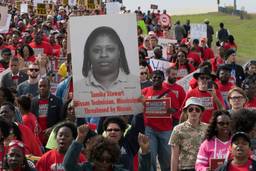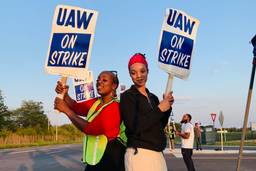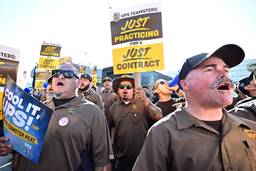The net change in jobs in America last month was a big fat zero. Cuts in government jobs wiped out private sector growth that would have been moderate even if the Verizon strike had not temporarily reduced employment.
The weak performance left the official unemployment rate at 9.1 percent, the same as last month. Prospects for the future are grim as well: the Congressional Budget Office forecasts 8.7 percent unemployment late next year. Also, reports that manufacturing output and orders are declining or growing at a slower pace throughout the major industrial and industrializing countries suggests a deepening or double-dip recession (depending on whether you think the recession ever ended).
The news is certainly bad for the 14 million Americans who are out of work. Conditions are especially grim for some, since only half of them receive unemployment insurance, and 43 percent have been unemployed six months or longer (a consequence of the job market offering one job for every 4.5 unemployed workers).
But does that mean that high unemployment is a problem just for them, not the other 90.9 percent of the workforce (not to mention those not in the workforce, like the elderly or children)? Not at all, Economic Policy Institute authors Lawrence Mishel and Heidi Shierholz report in a new study.
Of course, a few are doing well. Corporate profits are up by a third since the recession started, claiming 26.3 percent of corporate income for the past year, a post-World War II high. And corporate CEO salaries have rebounded dramatically, almost reaching previous highs as a multiple of average workers’ earnings.
While the wealthy took a hit from declines in stocks and other investments, the bottom four-fifths of households by income lost a much higher percentage of their assets on average (22.2 percent) than the top fifth, which lost 14.8 percent of average wealth from 2007-2009.
And the well-off could more easily absorb their loss when you take into account who accumulated wealth from 1983 to 2009. During that period the top fifth of households by wealth holdings captured 101.7 percent of the nation’s increased wealth. Yes, that’s right, they took virtually all newly created wealth in the United States, plus transferring some of the pittance belonging to the bottom 60 percent to their coffers. And the top one percent won control of 40.2 percent of increased wealth, while the next richest four percent got 41.6 percent.
Focusing just on unemployment, however, the effects of a high unemployment rate hit more than 9.1 percent. First, as the numbers without a job grow, there’s a rise in involuntary part-time work (up again last month to 8.8 million workers) and in the numbers of workers who wanted a job but had not actively looked in the last month, often because they were discouraged (up again last month to 2.6 million).
So the total unemployed or underemployed in August encompassed 25.3 million workers, or 25.8 percent of the workforce.
Yet even that represents a snapshot in time of a labor market that where people even in a recession are gaining or losing jobs. Mishel and Shierholz estimate that 31 percent of the workforce was unemployed or underemployed at some point in 2009.
(Numbers for black and Latino workers are always higher, roughly double white levels for most statistics on unemployment.)
But even full-time workers feel the pressures most acutely hurting the jobless. Their hours of work have dropped (and dropped again last month). EPI reports that “wage growth has been slower in the last two years than at any time over the last 30 years,” as employers take advantage of the army of unemployed.
As a result “the median working-age household saw an income decline of $2,700 from 2007 to 2009,” plus in many cases loss of all or part of benefits like health care or pensions. And since — for the first time – family incomes never recovered during the Bush years from the recession at the start of the decade (and job growth was weaker during Bush’s term than even the recovery under Obama), the “typical working-age household brought in roughly $4,000 less in 2009 than it did in 2000.”
Other people in a family obviously lose when the breadwinners lose jobs or incomes as well. In somewhere between 33 to 43 percent of families someone has been affected by unemployment over the past two years. The “unemployment” rate for children — that is, the percent of children with at least one unemployed parent — was 10.6 percent in 2010, higher than the official adult unemployment rate.
And the consequences of high unemployment undermine the job security, incomes and benefits of neighbors, whether they work in a factory or construction site for a private employer or in the offices of governments.
Despite disparities by region, occupation, education, race and other characteristics, most workers suffer from a high unemployment economy. The jobless rate for a high school graduate was 11.6 percent for the first half of 2011, compared to 3.2 percent for someone with an advanced degree. But the unemployment rate is still roughly double now what it was in 2007 for every educational level.
Losing a job — then not finding a replacement — hurts the most, but when the unemployment numbers toll, even if you have a job, they toll for thee.

I hope you found this article important. Before you leave, I want to ask you to consider supporting our work with a donation. In These Times needs readers like you to help sustain our mission. We don’t depend on—or want—corporate advertising or deep-pocketed billionaires to fund our journalism. We’re supported by you, the reader, so we can focus on covering the issues that matter most to the progressive movement without fear or compromise.
Our work isn’t hidden behind a paywall because of people like you who support our journalism. We want to keep it that way. If you value the work we do and the movements we cover, please consider donating to In These Times.
David Moberg, a former senior editor of In These Times, was on staff with the magazine from when it began publishing in 1976 until his passing in July 2022. Before joining In These Times, he completed his work for a Ph.D. in anthropology at the University of Chicago and worked for Newsweek. He received fellowships from the John D. and Catherine T. MacArthur Foundation and the Nation Institute for research on the new global economy.







